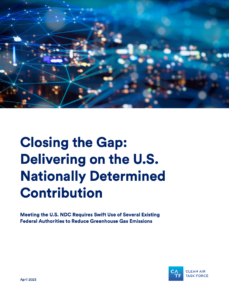Full Title: Closing the Gap: Delivering on the U.S. Nationally Determined Contribution
Author(s): Clean Air Task Force
Publisher(s): Clean Air Task Force
Publication Date: April 20, 2023
Full Text: Download Resource
Description (excerpt):
Swift U.S. action to reduce the U.S. contribution to greenhouse gas emissions is critical to keep global climate goals on track, advance domestic energy security, air quality, and economic competitiveness, and show leadership that can motivate other countries to take their own decisive climate actions. A fundamental aspect of this leadership requires the U.S. to stay on track to meet its Nationally Determined Contribution (NDC) to cut greenhouse gas emissions by 50-52% below 2005 levels by 2030. Despite the projected greenhouse gas reductions from the landmark Inflation Reduction Act (IRA) and Infrastructure Investment and Jobs Act (IIJA), the Princeton University REPEAT Project1 estimates that in 2030 there will be a gap of 810 million tonnes CO2e.
To keep the NDC goal within reach, the U.S. government must act with urgency over the next two years and take full advantage of existing Clean Air Act regulatory authority to control climate pollution. New analysis finds that closing the gap will require strong rules to limit emissions from new and existing power plants, vehicles, industrial operations, and oil and gas production, which can provide the lion’s share of the needed reductions. In addition, to completely close the gap, the federal government can use its
existing authority to prioritize carbon sequestration and mitigation from agriculture and forestry investments. These actions, targeting the main areas of opportunity, are under the control of the Administration and can yield the tonnes needed to meet the NDC.
To the degree the estimated emissions reductions from the broad set of federal actions falls short of the needed ambition, the cuts in greenhouse gas emissions to meet the promised 50-52% NDC goal would have to be found elsewhere in the economy. This would mean turning to smaller-scale mitigation opportunities or measures that depend on bipartisan legislation or multi-state actions; reliance on such measures would increase the chances that the U.S. would fail to meet its NDC. Accordingly, CATF calls on the Biden Administration to expeditiously issue stringent Clean Air Act greenhouse gas regulations on power plants, vehicles, industrial operations, and oil and gas production and to utilize existing authorities to ensure agriculture and forestry expenditures prioritize climate impacts. These actions, which target the largest emitters, can be implemented under existing federal authority, and offer the best chance of success to meet the U.S. NDC.
